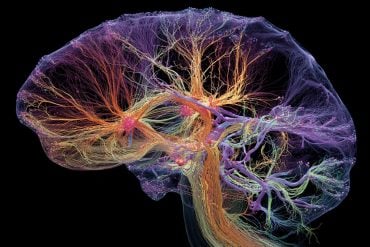Summary: Researchers used the simple worm, Caenorhabditis elegans, to gain profound insights into how neural information flows in the brain.
Using advanced techniques like optogenetics, they visually tracked signal flow in real-time, neuron by neuron, to chart its pathways. Contrary to predictions from the worm’s connectome map, they found critical “wireless signals” involving molecular releases affecting neural dynamics.
This groundbreaking research offers a stepping stone to understanding more complex brains.
Key Facts:
- The team studied C. elegans, a transparent worm with 302 neurons, making it an ideal model for mapping brain signal flow.
- Through pioneering optogenetics, they visualized real-time signaling, uncovering unexpected “wireless signals” using neuropeptides.
- Their findings challenge existing predictions based on the worm’s connectome, revealing molecular details crucial to understanding neural response.
Source: Princeton
Do we really know how the brain works?
In the last several decades, scientists have made great strides in understanding this fantastically complex organ. Scientists now know a great deal about the brain’s cellular neurobiology and have learned much about the brain’s neural connections, and the components that make up these connections.

Despite this, a whole host of important questions remain unanswered and, consequently, the brain continues to be one of science’s great, tantalizing mysteries.
Perhaps one of the most nagging of these questions revolves around our understanding of the brain as a system. Scientists are still largely in the dark about how the brain functions as a network of interacting components, about how all the neural components cooperate, and especially, how information is processed between and among this complex network of neurons.
Now, however, a team of neuroscientists and physicists at Princeton University are helping to shine a clarifying light on how information flows in the brain by studying, of all things, the brain of a very small but ubiquitous worm known as Caenorhabditis elegans. The details of the experiment are chronicled in a recent issue of Nature.
The team consisted of Francesco Randi, Sophie Dvali and Anuj Sharma and was led by Andrew Leifer, a neuroscientist and physicist.
“Brains are exciting and mysterious,” said Leifer. “Our team is interested in the question of how collections of neurons process information and generate action.”
Interest in this question has broad implications, Leifer added. Understanding how a network of neurons works is a specific example of a broader class of questions in biological physics, namely, how collective phenomena emerge from networks of interacting cells and molecules.
This area of research has implications for many topics relevant to biological physics as well as contemporary, cutting-edge technologies, such as artificial intelligence.
The first step in answering the question of how information is processed through a network of interacting neurons required that Leifer and his team find a suitable organism that could easily be manipulated in the lab.
This turned out to be C. elegans, an unsegmented, non-parasitic nematode, or roundworm, that has been studied by scientists for decades and is considered a “genetically model organism.” Model organisms are commonly used in the laboratory to help scientists understand biological processes because their anatomy, genetics and behaviors are well understood.
The worm is approximately one millimeter in length and is found in many bacteria-rich environments. Especially pertinent to the current study is the fact that the organism has a nervous system of only 302 neurons in its entire body, 188 of which reside in its brain.
“By contrast, a human brain has hundreds of billions of neurons,” said Leifer. “So, these worms are much simpler to study. In fact, these worms are excellent for experimentation because they strike just the right balance between simplicity and complexity.”
Importantly, added Leifer, C. elegans was the first organism to have its brain wiring fully “mapped.” This means that scientists have compiled a comprehensive diagram, or “map,” of all its neurons and synapses—the places where neurons physically connect and communicate with other neurons.
This field of endeavor is called “connectomics,” in the parlance of neuroscience, and a diagram of a comprehensive map of neural connections in the brain of an organism is known as a “connectome.” One of the main goals of connectomics is finding out specific nerve connections responsible for particular behaviors.
An additional advantage in using C. elegans in laboratory experiments is that the worm is transparent, and, in certain cases, its tissue has been genetically engineered to be light sensitive.
This area of research is known as “optogenetics” and it has revolutionized many aspects of experimentation in biological neuroscience. Instead of the more conventional system of using an electrode to deliver a current into a neuron and thereby stimulate a response, the optogenetic technique involves using light-sensitive proteins from certain organisms and implanting those cells in another organism so that researchers can control an organism’s behavior or responses using light signals.
Similarly, other proteins can be used to light up and report when one neuron signals to another. This means two important things for laboratory experimentation: that an organism will respond to the presence of light, and that a neuron, once it receives a signal from another neuron, will “light up.” This has allowed researchers to study the interaction of neurons visually.
“What is really powerful about this tool is that you can literally turn neurons on and watch them signal in real time,” said Leifer. “In essence, we can convert the problem of measuring and manipulating neural activity to one of collecting and delivering the right light to the right place at the right time.”
These optical tools allowed Leifer’s team to begin the painstaking task of understanding how information flows through the worm’s brain. The goal was to understand how signals flow directly through the worm’s entire brain, so each neuron had to be measured.
This involved isolating one neuron at a time, shining a light on it, so that it was “activated,” and then observing how the other neurons responded.
“For this experiment, we went one neuron at a time through the entire brain, activating or perturbing each neuron and then watching the whole network respond,” said Leifer. “This way, we were able to map out how signals flowed through the network.”
“This was an approach that had never been done before at the scale of an entire brain,” added Leifer.
In all, Leifer and his team performed nearly 10,000 stimulus events by measuring over 23,000 pairs of neurons and their responses, a task that took seven years from conception to completion.
The research conducted by Leifer and his team is thus far the most comprehensive description of how signals flow through the brain. For scientists who study C. elegans, the researchers provided a lot of information for how specific signals work in the worm’s brain, and it is hoped that this research will provide a plethora of new information that will help advance basic research.
An equally important finding was that a number of the empirical observations Leifer and his team made during the experiment often contradicted the predictions of worm behavior based on mathematical models derived from the worm’s connectome map.
“We concluded that, in many cases, many molecular details that you can’t see from the wiring diagram are actually very important for predicting how the network should respond,” said Leifer.
The researchers suggest that there is a form of signaling—part of the “molecular details that you can’t see”—that does not progress along neural wires. Leifer and his group characterized these as “wireless signals.”
Although wireless signaling is well known among neuroscientists, it has largely been underappreciated for studying neural dynamics because it had often thought to be a process that occurs very slowly.
Wireless signaling is a form of signaling by which a neuron releases molecules, called neuropeptides, into the extracellular space, or “extracellular milieu,” between neurons. These chemicals diffuse and bind to other neurons even if there is no physical connection between them.
Finally, the researchers believe that an important impact of their work is that it allows other neuroscientists studying this and similar phenomena to develop better models with which to understand the brain as a system.
“With our research, we provided a very important piece of the puzzle that was missing,” said Leifer.
Funding: This work was primarily supported by the National Institute of Health New Innovator Award, a National Science Foundation CAREER Award, and an award from the Simons Foundation. Funding was also received from an NSF Physics Frontier Center grant that supports Princeton University’s Center for Physics of Biological Function.
About this neuroscience research news
Author: Catherine Zandonella
Source: Princeton
Contact: Catherine Zandonella – Princeton
Image: The image is credited to Neuroscience News
Original Research: Open access.
“Neural signal propagation atlas of Caenorhabditis elegans” by Andrew Leifer et al. Nature
Abstract
Neural signal propagation atlas of Caenorhabditis elegant
Establishing how neural function emerges from network properties is a fundamental problem in neuroscience.
Here, to better understand the relationship between the structure and the function of a nervous system, we systematically measure signal propagation in 23,433 pairs of neurons across the head of the nematode Caenorhabditis elegans by direct optogenetic activation and simultaneous whole-brain calcium imaging.
We measure the sign (excitatory or inhibitory), strength, temporal properties and causal direction of signal propagation between these neurons to create a functional atlas. We find that signal propagation differs from model predictions that are based on anatomy.
Using mutants, we show that extrasynaptic signalling not visible from anatomy contributes to this difference. We identify many instances of dense-core-vesicle-dependent signalling, including on timescales of less than a second, that evoke acute calcium transients—often where no direct wired connection exists but where relevant neuropeptides and receptors are expressed. We propose that, in such cases, extrasynaptically released neuropeptides serve a similar function to that of classical neurotransmitters.
Finally, our measured signal propagation atlas better predicts the neural dynamics of spontaneous activity than do models based on anatomy. We conclude that both synaptic and extrasynaptic signalling drive neural dynamics on short timescales, and that measurements of evoked signal propagation are crucial for interpreting neural function.






